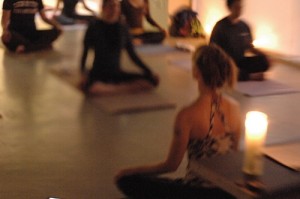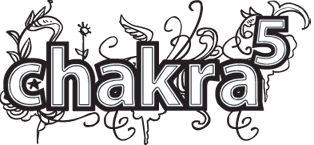Approaching New Year’s Health Resolutions the Chakra 5 Way
 Feliz año nuevo my dear Chakra 5 friends!
Feliz año nuevo my dear Chakra 5 friends!
You’ve probably noticed a lot of specials and offers bombarding you everywhere from yoga studios, gyms, home delivery meal services, juicing/detox services, etc….it’s that fun time of year again in which we all resolve to shape up and clean up some bad habits when it comes to eating, working and living.
I wanted to share a question that came to me from one of our Facebook fans:
I am going to start doing yoga, but need a lil direction on how to begin. Trying to regain my flexibility and balance. It’s embarrassing to admit, but if I’ve been seated for too long, when I get up to move…I look like I’m 80yrs old. BLECH! Nothing sez sexy like a tentative waddle across the room. Also looking for any general detox advice. All the raw/vegan stuff seems too extreme for my goals.
First of all, I commend you for your inspiration to be healthier! The key to succeeding in this endeavor is to set some realistic goals and gently, gradually, working towards achieving them. I’m going to recommend an approach to your yoga and eating goals that is heavily colored by my own experiences and philosophy. However, I’d like to think there is some strong, common sense behind these recommendations based on hard evidence and research as well.
Getting Started With Yoga
First, easy does it! If it has been a long time since you’ve practiced, or, in my friend’s case, possibly your first time trying yoga, the first thing I would keep in mind is the yogic concept of vairagya, which means “renunciation” to your limits or “detachment” from too aggressive goals. I have countless stories from people who went too hard with the yoga and hurt themselves, including myself. Check out this article about the rise of injuries in yoga classes. Take into account your age, your current fitness level, and your own unique strengths and weaknesses physically…which will morph interestingly throughout your yoga practice. Yes! I said “practice”. There is no end to what you experience and discover about yourself in yoga, and there should be no goals except to simply experience it as often as you can, and, as I often say in my classes: “find your edge and gently work with it”. Instead of a 2 hour “power yoga” class every day, aim for a beginner class 2-3 times/week and go up from there. I also truly believe in smaller “pods” of yoga poses done in a 20 minute session as a supplemental practice between classes at a studio. That 20 minute session should include 5 minutes of warm ups (like seated cat/cow or seated twists), 10 minutes of flowing and standing poses (like warriors and sun salutations) and 5 minutes of cool downs (like “legs up the wall”). The intensity of the home practice will obviously vary depending on your level of fitness. You can try a DVD or many of the great Yoga Journal Podcast videos to practice with at home.

Second, I highly recommend finding a yoga studio near you that offers an “Intro to Yoga” class. They are often quite a bargain and they are a great opportunity for beginners to get a good starting foundation of seated and standing level 1 poses. Look on Yelp! for a studio that has gotten some good reviews from customers, especially yoga newbies. Smaller studios without huge, over-sized classes can give you more personal attention. Feel free to call the studio ahead of time to explain your current level of fitness, any injuries, etc. Any instructor worth his/her weight will gracefully take into account your unique issues and find a way to help you gently enter into your practice. The most common injury-prone areas for yoga students are the neck, lower back, shoulders and wrists. Your teacher should always pay close attention to correct alignment. If you can afford the splurge, try buying a book of private sessions with a teacher.
Finally, as for your ongoing practice, be realistic about what you can sustain. Again, I recommend a daily home practice, even if it’s just 20 minutes. Set an alarm on your phone and make it a ritual to which you dedicate yourself. You will see more results by keeping up with yoga over time. I still recommend sticking with a studio that you like, attending at least one class per week. I still go all the time to other teachers’ classes. I need an external eye looking at my form, and I need the community. That seems to be the case with most of us. Don’t be afraid to try out other studios as well.
You can also start a yoga program at the office, which is obviously convenient and especially motiviating since you can experience the benefits of the classes together with your coworkers. This article outlines many of the health, financial and productivity benefits of office yoga that will help you make the case to your HR Director.
My POV: a truly decent yoga class should include plenty of work on proper breath and meditation. For the best yoga experience, it really is the combination of rhythmic breath, mental focus and physical poses (asana) that make for the best health benefits!
Detox (a.k.a. “Clean Eating”)
I’m going to share my thoughts on the whole “detox” craze, and please note that I don’t hold a degree in nutrition. But here’s my take…remember, this is my OPINION.
I still have YET to see any scientific evidence of benefits from long term fasting. There is a huge craze out here in LA to do the Master Cleanse (10+ days of eating nothing but hot water, lemon juice, maple syrup and cayenne pepper) or doing one of the countless, trendy and expensive detox programs with a dozen supplements and powders that seem to blow up your GI system. Trendy juice programs are expensive and mainline so much sugar into your system. If you want to do juice, I recommend a pure green juice as an occasional meal replacement.
People tend to project lofty expectations on these programs and the benefits are largely perceived. Any “weight loss” is mostly water and muscle! Why do people quickly forget that more muscle mass is what creates a gorgeous physique? All that hard work building muscle in the gym or in your yoga classes and you want to fast for a week and lose it?
No thanks.
Nonetheless, I have friends who love doing this and get a lot out of it, so I cannot stand in the way of what they believe makes them feel great. They “lose” 8 pounds in a week, then they get a cold because their immune system is down. Way to go!
Now having had my rant, let me say that I certainly think occasional short term fasting can be 1) a beautiful spiritual experience and 2) somewhat beneficial to your health. There are studies coming out that short term fasting for a day or two, or even “intermittent fasting”, in which you only eat within an 8 hr window, can have some biological benefits and can jump start your metabolism, as these techniques mimic the ebb and flow of available food our bodies were used to in paleolithic times.
As for raw food, I am a fan, but I limit it in my diet. I try to eat at least 50% raw every day. Ayurvedic and Chinese medicine both teach that eating cold, uncooked food can be bad for the digestion for many people. I think it’s a personal choice. My body type tends to have weak digestion/elimination, so I take it easy on the raw stuff. You don’t have to eat a wildly exotic “triple layer goji berry nut paste cake” to eat raw. Eating raw can simply be a lunch consisting of a banana, avocado, fresh chopped salad and some homemade almond milk.
It makes more sense to dedicate yourself to a “clean eating” program for several weeks if you’d like to start off the new year right. That means eating fresh, whole, plant-based foods that don’t come in packages and eliminating the foods that cause sensitivities. Then try adding the foods back into your diet one at a time, to see if you feel any adverse affects from particular ones. You may find you’ll feel infinitely better eliminating or greatly reducing something from your diet. In Food Rules, Michael Pollan has a simple strategy: “Eat food. Not too much. Mostly plants”.
Here’s a simple approach to a New Year’s 2 Week Detox:
1) Eliminate caffeine, alcohol, dairy, gluten (wheat, etc) and meat.
2) Vow to drink 8 glasses of water daily (8 ounces per glass)
3) Eat protein-rich, gluten-free whole grains such as Quinoa and Amaranth. Check out this list of gluten-free grains.
4) Eat lots of vegetables full of color, like roasted carrots and sweet potatoes and dark green veggies like Kale and Arugula. the Chakra 5 blog has some recipes.
5) Soups are a very nourishing way to deliver nutrients to your body, and they are very filling. Try vegetable-based soups full of detoxifying veggies like kale and white beans.
6) I love ending my day with a simple ginger tea that I make all the time at home. Helps digestion and acts as a wonderful antibacterial elixir: Combine 1 tbsp grated ginger, 1 tsbp lemon juice and 1 tsp honey in hot water. I use a loose leaf tea cup you can just drink right out of (has a filter in the top) from LibreTea.
I hope these thoughts and recommendations give you a great starting point for a new wellness program for the coming year. Make it one that is realistic and sustainable. Believe it or not, we can even go overboard with…being “healthy”!
McKenna Rowe is the Founder of Chakra 5 Mobile Yoga, an experienced team of corporate yoga instructors that provides mobile yoga classes on location and by appointment at businesses, schools and organizations throughout greater Los Angeles. Call us to start your corporate wellness program today: 310-853-3885.

